


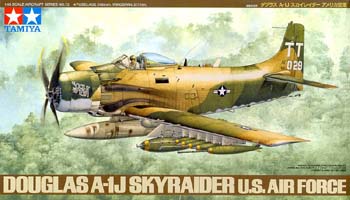 Tamiya
1/48 Douglas A-1J Skyraider (USAF)
Tamiya
1/48 Douglas A-1J Skyraider (USAF)
By Michael Benolkin
Background
When the Douglas AD Skyraider entered service in the mid-1940s, it came along too late to fight in the Second World War. Starting life as the XBT2D-1 Dauntless II, the aircraft received a new designation and name as it came off the production lines in El Segundo, CA - the AD-1 Skyraider.
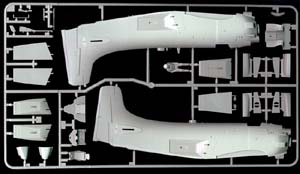 |
 |
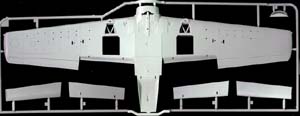 |
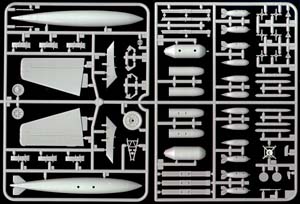 |
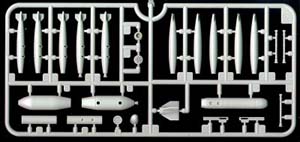 |
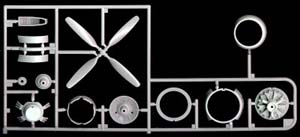 |
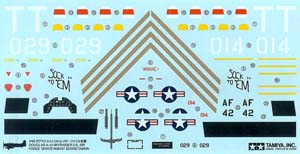 |
The Skyraider would not have long to wait before entering combat - it saw service in Korea a few short years later. In the early 1960s, the then Defense Secretary Robert McNamara enacted the directive for a common aircraft designator system between the US armed forces. After the changeover, the AD-5 became the A-1E, the AD-6 became the A-1G, etc.
The last of the USN Skyraiders was the A-1J (AD-7), featuring a more powerful engine, strengthened landing gear, nuclear capability, etc. Despite the capabilities of the A-1J, the Navy was moving swiftly forward with their jet-powered attack fleet based on the A-4 Skyhawk and A-6 Intruder. In fact, the Skyraider would be one of the last piston-powered developed for the US Navy.
As the Navy continued to modernize during the mid-to-late 1960s, the United States was becoming more involved with the conflict in Southeast Asia. The USAF had also been focused on modernizing their aircraft toward the strategic nuclear threat. The SEA conflict left the USAF lacking in close air support capabilities, so they pulled a number of A-26 Intruders out of mothballs and 'borrowed' a group of Skyraiders from the Navy. These aircraft served in a stopgap role until a more permanent solution could be fielded. Ironically, the only aircraft that could adequately replace the load carrying capability and low-level survivability of the A-1 was the A-10 Thunderbolt II.
The Kit
When Tamiya released their A-1H a few years ago, their kit was instantly the best Skyraider available in any scale. Because the A-1H and A-1J were very similar, Tamiya was able to reuse most of the parts from its A-1H release. What is new in this release is the Yankee Ejection Seat, an impressive array of ordnance (everything short of the kitchen), and USAF markings.
As is trademark Tamiya, the kit is molded in light grey plastic featuring very finely molded details, scribed panel lines, and an impressive array of detail parts. As I mentioned before, this kit is virtually identical to the earlier A-1H release, the parts trees are identical except for the change of crew seats. The old pilots seat has been replaced on the sprue with the Yankee seat. Two new parts trees are also added containing the SUU-11 gunpods (2), LAU-68 rocket pods (2), Mk.117 750lb bombs (2), and Mk.82 500lb bombs (10). Six fuse extenders are also provided.
As you can see from the parts scans, the Tamiya kit provides a wealth of detail inside the kit and out. Despite the apparent complexity of the kit, assembly is very straightforward and the fit is extremely nice. I haven't heard of anyone requiring filler on the A-1H release, so I would imagine that nothing has changed with this version.
Engine details, for instance, are the best of any Skyraider kit produced in any scale. The kit features the cowl flaps open, a nicely executed exhaust stack header, and a choice of open or closed intake shutters.
Another innovation that Tamiya has been introducing into its kits is present here as well. Larger external stores, such as the centerline and wing external fuel tanks, have poly caps installed inside the mounting holes to provide some 'give' when the kit is jostled about. The design engineering in this kit is very much the signature of current Tamiya products!
Tamiya provides markings for two aircraft: both from the 602nd SOS/56th SOW. Aircraft 42-014 is a commanders aircraft wearing the air commando stripes, and aircraft 42-029 'Sock it to em'. A very nice touch with the decals is that Tamiya included the propeller tip markings as decals, and even provided the Navy-standard red/white tips as well as the USAF yellow tips.
I'd recommend this kit to any builder with some building experience. There are no difficulties in construction, but given the number of parts involved, some building experience is recommended.
My sincere thanks to HobbyLink Japan for this review sample!

Previous: Contents







